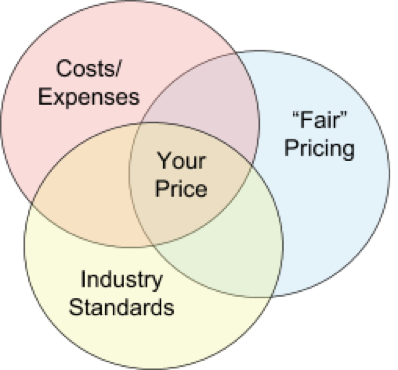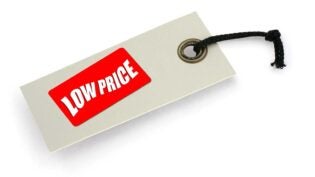
Developing a pricing strategy may not be a science, but sometimes it can feel about as difficult as performing brain surgery or engineering rocket ships! Service businesses are at particularly high risk of pricing confusion. It’s much trickier to put a dollar value on things like time and expertise than to determine the cost of producing a physical unit. As a result, many service businesses and independent contractors undervalue their services and fail to calculate their costs accurately.
While there’s no single formula for figuring out the perfect pricing strategy for your services, the following method will help you determine an appropriate range.
4 steps to profitable pricing
The three biggest factors in your pricing strategy should be your annual costs, industry standards (for profit and revenue), and what your customers consider “fair.” You should always break even, keep a pulse on your competitors, and stay within the limits of what customers are willing to pay.
1. Figure out your labor costs
Determining the “cost of labor” is a thorn in many service business owner sides. Whether you use flat-fee or hourly pricing, deciding how much you or your employees’ time is worth is uncomfortably subjective.
Simply determining what exactly counts as a labor cost can also prove challenging. In one extreme, a freelancer might consider their income equivalent to the profit of their freelance business. In this case, their labor costs could be zero (unless they subcontracted other freelancers to do part of their work). In the other extreme, a consulting firm’s founder and CEO may count her salary and benefits, as well as all her employees’, as labor costs. In this case, the company’s profits are totally independent of her earnings.
The key in either case is remembering to account for your own income, as well as related expenses like income taxes and benefits. Whether you count benefits as labor costs or overhead, whether your income is fixed or based on your profits, your financial calculations need to reflect all these factors.
If you’re working independently, there’s one simple (if imperfect) way to determine your own hourly wage. Start with the net income you need to have to support yourself. Let’s say it’s $40,000. Then estimate how many billable hours you will work in the year. Let’s say it’s half of the working hours of a standard full-time job, or 1000 hours. Divide your annual income by your annual hours.
$40,000 / 1000 hours = $40/hour
Check this number against your competitors. If your hourly wage is much lower than others in your field with comparable expertise and experience, consider increasing it.
2. Add up material and overhead costs
Because time is their most valuable asset, service business owners can easily forget that they are paying for certain resources, such as rent and electricity, to get their work done. These costs should be reflected in your pricing strategy.
Material costs are direct costs. They include anything you buy or use for a service, such as WordPress templates for web design services.
Overhead costs are indirect. They are expenses you incur just from running your business day to day rather than taking on any specific client or project. Like material costs, they should be reflected in your pricing strategy so they don’t eat into your profits.
Overhead costs include administrative assistance, rent, taxes, supplies, phone service, utilities, delivery, business insurance, travel costs, legal and accounting fees, association memberships, advertising & marketing, and work-related meals & entertainment. You could also include income & self-employment taxes, as well as insurance and retirement, as overhead rather than labor costs. Be sure to review your overhead costs every year and adjust your pricing accordingly; they are likely to increase.
3. Research your industry
Once you know your costs, you can calculate your breakeven point—how much revenue you need to stay in the black. If your annual costs amount to $35K, your services should be earning you more than $35K. But how much more?
Understanding competitors in your industry and prospects in your market will let you gauge how much profit you can expect to make. Use industry-specific and general resources to check how well your net profit margin and revenue matches that of comparable businesses. According to Yahoo’s daily industry summary, net profit margins range from almost 40% for real estate development to -60% for the silver industry.
The SBA has a simple, powerful tool called SizeUp that will help you compare your business to others in your city and industry. You can also do your own research by visiting competitor websites, making calls, and talking to friends or customers who have worked with businesses in your industry.
4. Listen to your customers
The customer may not always be king, but they are the deciding vote in whether or not you’re able to sell your services. Finding out what competitors charge and what industry standards are for your business will help you figure out what people are willing to pay for comparable services. At the same time, prospects may be willing to pay significantly more or significantly less for your specific services for various reasons. It all depends on a thousand subjective factors into our unconscious reasoning about what is “fair.”
The best way to find out what customers are willing to pay is to ask. Have face-to-face conversations with current customers or prospects and get their feedback on how much they would pay for x and y service. Find out what benefits (such as great communication or prompt delivery) matter enough to them to pay more. If you start hearing that your services are a “bargain,” consider raising your prices.
While you’re listening, remember: There will always be someone who considers reasonably just prices unfair. As long as you have enough customers willing to pay a price that lets you earn a profit, you don’t need to worry about what the rest of the world thinks about your pricing strategy. While pricing may be more of an art than a science, it’s an art yields measurable results. A careful pricing strategy is an important piece in the puzzle of a healthy, profitable business.
Author: Michael Jones is the Director of Community Development at Bond Street, a company focused on making small business loans simple, transparent, and fair. Contact Michael at Michael@Bondstreet.com













